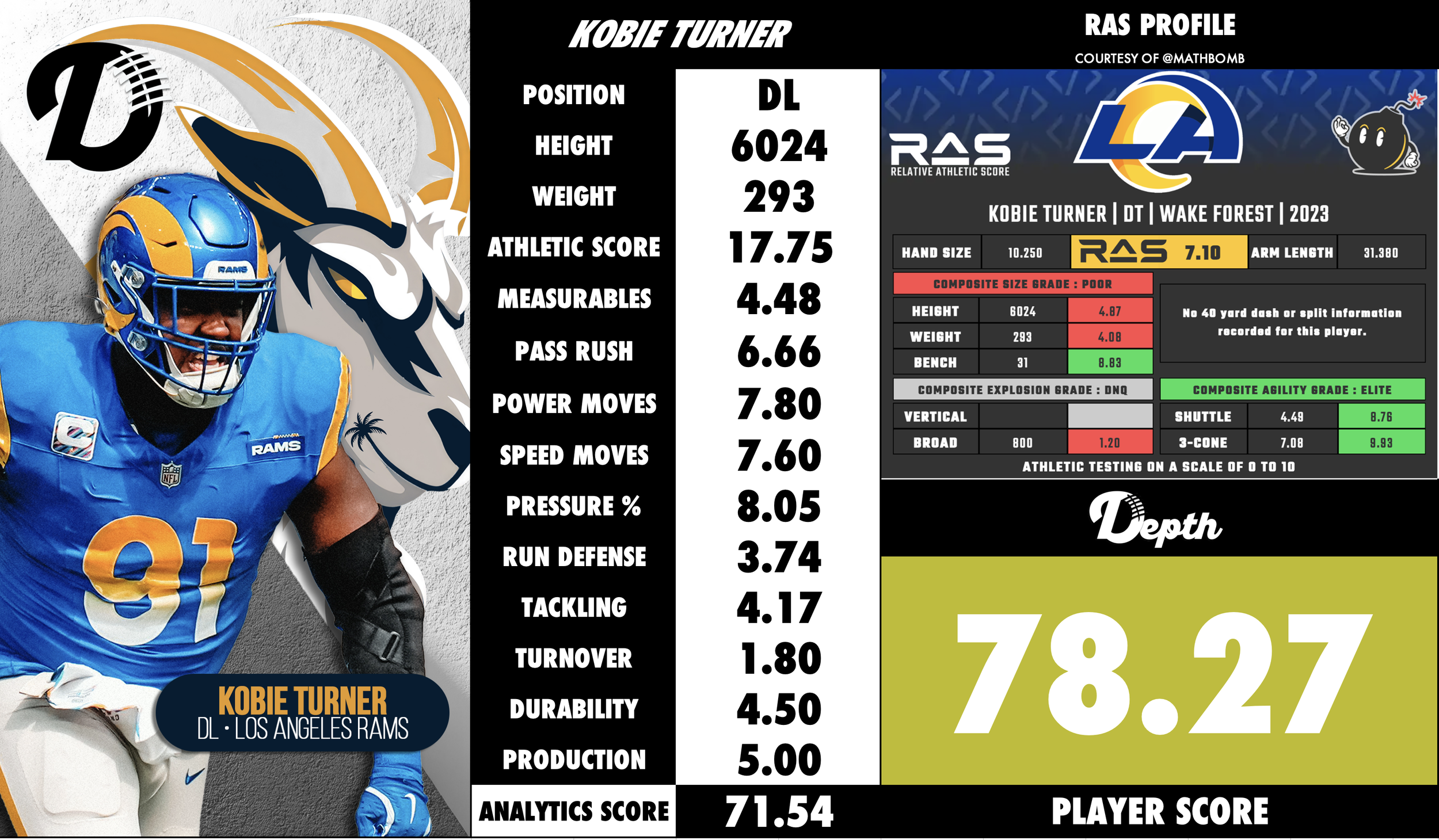
Kobie Turner
Summary
Kobie Turner was selected in Round 3 (#89 Overall) in the 2023 Draft out of Wake Forest University. Turner entered the NFL as a high‑motor, technically adept interior defensive lineman with a strong finish in his final collegiate season at Wake Forest after transferring from Richmond. He showed a knack for leverage, hands, pursuit and disruption despite being undersized for a conventional 3‑tech. His projection was as a rotational interior rusher who could develop into a starter given his traits and motor. Early NFL performance suggests he is outperforming expectations.
Strengths
Explosive get‑off and strong first step: Turner flashes quickness off the snap, enabling him to penetrate gaps and disrupt plays. Bleacher Report
Excellent leverage and hand‑usage for his size: He routinely wins battles at the point by staying low, using power in his hands, and defeating blocks through technical execution. NFL Draft Buzz
High‑motor, pursuit‑downfield effort: Turner brings consistent effort on every play—chasing plays laterally, showing hustle and finishing in run‑support and pass‑rush.
Versatility in technique and alignment: He can play multiple spots inside, execute stunts and loops, and respond to movement fronts—adding schematic value. PFSN
Run‑defender capability and ability to collapse pockets: While primarily projected as a rush‑interior, he shows effectiveness in run‑defense zones and the ability to disrupt timing in pass protection.
Weaknesses
Below‑ideal size/length for the interior line: At around 6′3″ and ~288–295 lbs, with shorter arms, Turner lacks the prototypical mass and reach of some 3‑techs and may be vulnerable when double‑teamed or anchored. NFL Draft Buzz
Limited pure bull‑rush power and occasional balance issues: While technically sound, he doesn’t always generate impact with sheer strength and has shown times when a block or cut in space exposes his balance or mass disadvantage. Bleacher Report
Athletic ceiling may be constrained: He is not a “freak” athlete in terms of speed or bend, which may limit his ability to dominate elite interior rushers in all matchups.
Sample size and experience against top‑level competition are limited: Because much of his development came at Richmond (FCS) and only one season at Wake Forest, evaluators had fewer reps against the highest level of competition.
Ceiling somewhat tied to scheme and role: Turner may maximize value in one‑gap, penetrating schemes rather than two‑gap heavy fronts; mis‑alignment in a non‑ideal scheme could reduce his impact. PFSN
Fit & Outlook
Turner fits best in a defensive front that emphasizes penetration, one‑gap techniques, frequent interior stunts and rotation of defensive tackle/three‑tech personnel—essentially schemes that allow him to attack rather than anchor. A system that uses his quick first step, leverage‑based game and motor will get the most out of him. He may be less ideal in a heavy two‑gap, off‑blocker scheme where the interior lineman must constantly anchor without rotation or seldom rush. Looking ahead, Turner’s outlook is very promising. His floor is that of a solid rotational interior defensive lineman who can contribute on early downs, sub‑packages and provide disruptive plays in the pass rush. His upside is more significant: if he continues to develop his strength, hand‑technique and adjusts to the pro game, he could become a full‑time starter interior rusher who produces high sack numbers and solid run‑defense. The key variables will be health, continued technical refinement, adequate scheme fit, and whether he is used in a role that amplifies his strengths rather than exposing his size/length limitations.


